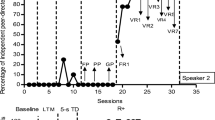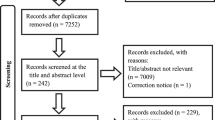Abstract
Since its introduction to the field, a growing body of research on the Picture Exchange Communication System (PECS) has demonstrated its efficacy for children with autism in research settings. However, knowledge of PECS generalization remains limited and mixed. The present study explored a train and probe technique of assessing generalization after each phase of PECS training. Four children with autism were taught PECS in treatment rooms with a therapist at their behavioral treatment program. Generalization was assessed in a playroom with a therapist, at home with a therapist and parent, and in the community with a stranger. Results indicated that all four participants generalized PECS use across settings and people and maintained PECS use at follow-up. Findings provide support for the utility of a train and probe technique to assess generalization when using PECS with children with autism.

Similar content being viewed by others
References
Adkins, T., & Axelrod, S. (2002). Topography versus selection-based responding: comparison of mand acquisition in each modality. The Behavior Analyst Today, 2, 259–266.
American Psychiatric Association. (2000). Diagnostic and statistical manual of mental disorders (Revised 4th ed.). Washington, DC: Author.
Anderson, A., Moore, D. W., & Bourne, T. (2007). Functional communication and other concomitant behavior change following PECS training: a case study. Behaviour Change, 24, 173–181. doi:10.1375/bech.24.3.173.
Bock, S. J., Stoner, J. B., Beck, A. R., Hanley, L., & Prochnow, J. (2005). Increasing functional communication in non-speaking preschool children: comparison of PECS and VOCA. Education and Training in Developmental Disabilities, 40, 264–278.
Bondy, A. S., & Frost, L. A. (1993). Mands across the water: a report on the application of the picture-exchange communication system in Peru. Behavior Analyst, 16, 123–128.
Bondy, A. S., & Frost, L. A. (1994). The picture exchange communication system. Focus on Autistic Behavior, 9, 1–19.
Carr, D., & Felce, J. (2007a). Brief report: increase in production of spoken words in some children with autism after PECS teaching to phase III. Journal of Autism and Developmental Disorders, 37, 780–787. doi:10.1007/s10803-006-0204-0.
Carr, D., & Felce, J. (2007b). The effects of PECS teaching to phase III on the communicative interactions between children with autism and their teachers. Journal of Autism and Developmental Disorders, 37, 724–737. doi:10.1007/s10803-006-0203-1.
Carré, A. J., Grice, B. L., Blampied, N. M., & Walker, D. (2009). Picture Exchange Communication (PECS) training for young children: does training transfer at school and to home? Behaviour Change, 26, 56–65. doi:10.1375/bech.26.1.54.
Chambers, M., & Rehfeldt, R. A. (2003). Assessing the acquisition and generalization of two mand forms with adults with severe developmental disabilities. Research in Developmental Disabilities, 24, 265–280. doi:10.1016/S0891-4222(03)00042-8.
Charlop-Christy, M. H., Carpenter, M., Le, L., LeBlanc, L. A., & Kellet, K. (2002). Using the Picture Exchange Communication System (PECS) with children with autism: assessment of PECS acquisition, speech, social-communicative behavior, and problem behavior. Journal of Applied Behavior Analysis, 35, 213–231. doi:10.1901/jaba.2002.35-213.
DeLeon, I. G., & Iwata, B. A. (1996). Evaluation of a multiple-stimulus presentation format for assessing reinforcer preferences. Journal of Applied Behavior Analysis, 29, 519–532. doi:10.1901/jaba.1996.29-519.
DeLeon, I. G., Iwata, B. A., & Roscoe, E. M. (1997). Displacement of leisure reinforcers by food during preference assessments. Journal of Applied Behavior Analysis, 30, 475–484. doi:10.1901/jaba.1997.30-475.
Frea, W. D., Arnold, C. L., & Vittemberga, G. L. (2001). A demonstration of the effects of augmentative communication on the extreme aggressive behavior of a child with autism within an integrated preschool setting. Journal of Positive Behavior Interventions, 3, 194–198. doi:10.1177/109830070100300401.
Frost, L., & Bondy, A. (2002). Picture exchange communication system training manual (2nd ed.). Newark: Pyramid Educational Consultants.
Ganz, J. B., & Simpson, R. L. (2004). Effects on communicative requesting and speech development of the picture exchange communication system in children with characteristics of autism. Journal of Autism and Developmental Disorders, 34, 395–409. doi:10.1023/B:JADD.0000037416.59095.d7.
Ganz, J. B., Simpson, R. L., & Corbin-Newsome, J. (2008). The impact of the picture exchange communication system on requesting and speech development in preschoolers with autism spectrum disorders and similar characteristics. Research in Autism Spectrum Disorders, 2, 157–169. doi:10.1016/j.rasd.2007.04.005.
Greenberg, A. L. (2011). Addressing the research-to-practice gap in autism treatments: Applying an effectiveness research model to the picture exchange communication system. (Doctoral dissertation, Claremont Graduate University, 2011)
Horner, R. H., & Budd, C. M. (1985). Acquisition of manual sign use: collateral reduction of maladaptive behavior, and factors limiting generalization. Education and Training of the Mentally Retarded, 20, 39–47.
Jurgens, A., Anderson, A., & Moore, D. W. (2009). The effect of teaching PECS to a child with autism on verbal behaviour, play, and social functioning. Behaviour Change, 26, 66–81. doi:10.1375/bech.26.1.66.
Kravits, T. R., Kamps, D. M., Kemmerer, K., & Potucek, J. (2002). Brief report: increasing communication skills for an elementary-aged student with autism using the picture exchange communication system. Journal of Autism and Developmental Disorders, 32, 225–230. doi:10.1023/A:1015457931788.
Liddle, K. (2001). Implementing the Picture Exchange Communication System (PECS). International Journal of Language & Communication Disorders, 36, 391–395. doi:10.3109/13682820109177917.
Magiati, I., & Howlin, P. (2003). A pilot evaluation study of the Picture Exchange Communication System (PECS) for children with autistic spectrum disorders. Autism, 7, 297–320. doi:10.1177/13623613030073006.
Marckel, J. M., Neef, N. A., & Ferreri, S. J. (2006). A preliminary analysis of teaching improvisation with the picture exchange communication system to children with autism. Journal of Applied Behavior Analysis, 39, 109–115. doi:10.1901/jaba.2006.131-04.
Mayer-Johnson Company. (1994). The picture communication symbols combination book. Solana Beach, CA: Author.
National Research Council. (2001). Educating children with autism. Washington, DC: National Academy Press.
Preston, D., & Carter, M. (2009). A review of the efficacy of the picture exchange communication system intervention. Journal of Autism and Developmental Disorders, 39, 1471–1486. doi:10.1007/s10803-009-0763-y.
Schopler, E., Reichler, R. J., & Renner, B. R. (1988). Childhood autism rating scale. Los Angeles: Western Psychological Services.
Sparrow, S., Ball, D., & Cicchetti, D. (1984). Vineland adaptive behavior scale. Circle Pines: American Guidance Service.
Stokes, T. F., & Baer, D. M. (1977). An implicit technology of generalization. Journal of Applied Behavior Analysis, 10, 349–367. doi:10.1901/jaba.1977.10-349.
Stoner, J. B., Beck, A. R., Bock, S. J., Hickey, K., Kosuwan, K., & Thompson, J. R. (2006). The effectiveness of the picture exchange communication system with nonspeaking adults. Remedial and Special Education, 27, 154–165. doi:10.1177/07419325060270030401.
Sulzer-Azaroff, B., Hoffman, A. O., Horton, C. B., Bondy, A., & Frost, L. (2009). The Picture Exchange Communication System (PECS): what do the data say? Focus on Autism and Other Developmental Disabilities, 24, 89–103. doi:10.1177/1088357609332743.
Tincani, M. (2004). Comparing the picture exchange communication system and sign language training for children with autism. Focus on Autism and Other Developmental Disabilities, 19, 152–163. doi:10.1177/10883576040190030301.
Tincani, M., Crozier, S., & Alazetta, L. (2006). The picture exchange communication system: effects on manding and speech development for school-aged children with autism. Education and Training in Developmental Disabilities, 41, 177–184.
Wolf, M. M. (1978). Social validity: the case for subjective measurement, or how behavior analysis is finding its heart. Journal of Applied Behavior Analysis, 11, 203–214. doi:10.1901/jaba.1978.11-203.
Ziomek, M. M., & Rehfeldt, R. A. (2008). Investigating the acquisition, generalization, and emergence of untrained verbal operants for mands acquired using the picture exchange communication system in adults with severe developmental disabilities. The Analysis of Verbal Behavior, 24, 1–10.
Author information
Authors and Affiliations
Corresponding author
Rights and permissions
About this article
Cite this article
Greenberg, A.L., Tomaino, M.A.E. & Charlop, M.H. Assessing Generalization of the Picture Exchange Communication System in Children with Autism. J Dev Phys Disabil 24, 539–558 (2012). https://doi.org/10.1007/s10882-012-9288-y
Published:
Issue Date:
DOI: https://doi.org/10.1007/s10882-012-9288-y




